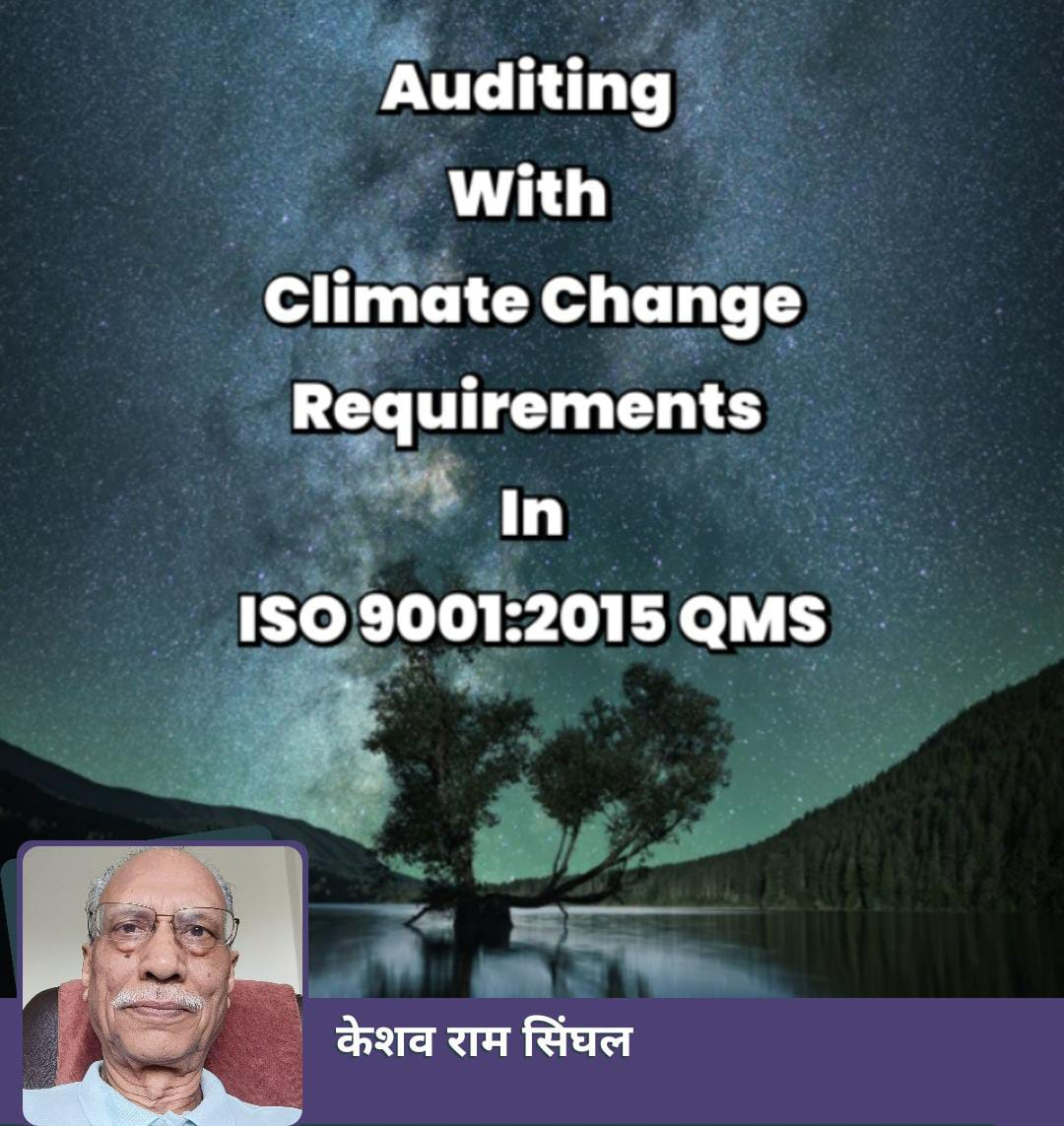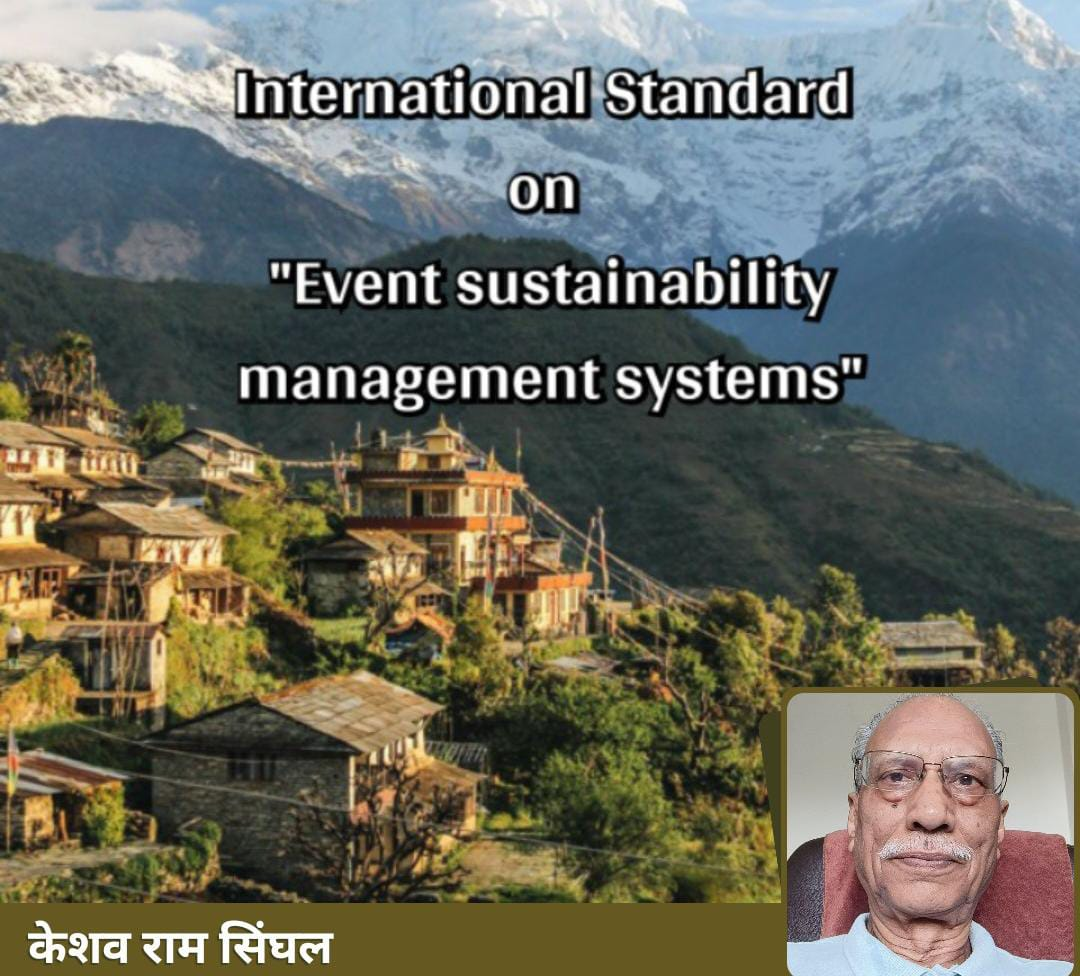Auditing With Climate Change Requirements In ISO 9001:2015 QMS – 1
=======
As you are aware that ISO member bodies unanimously approved ISO’s
commitment to action on climate change. This ISO’s commitment is known as London
Declaration. Thereafter, in February 2024, amendments to over 30 of ISO’s
management system standards, including ISO 9001:2015 QMS standard, have been
issued to include climate change considerations. Accordingly, clause 4.1 and
clause 4.2 of ISO 9001:2015 QMS standard have been amended by adding the
following requirement and note:
Clause 4.1 – Added requirement – The organization needs to determine
whether climate change is a relevant issue.
Clause 4.2 – Added note – Relevant interested parties can have needs and
expectations related to climate change.
If we look to the above amendments, we find that the overall intention
of the standard requirements remains unchanged. Clause 4.1 and clause 4.2
already included the requirements for the organization to consider internal and
external issues that can impact the effectiveness of the organization’s quality
management system.
The basic points behind including the requirement in clause 4.1 and note
in clause 4.2 are as under:
(1)
To ensure that the organization firmly consider
climate change issue.
(2)
To ensure that the organization firmly provide
special attention to consider climate change as one of the external issues in
designing and implementing the organization’s quality management system
In 2003, an informal group of quality management system experts,
auditors and practitioners drawn from International Organization for
Standardization Technical Committee (ISO/TC 176) and International
Accreditation Forum (IAF) as ‘ISO 9001 Auditing Practice Group’ was constituted
that provide guidance on matters related to ISO 9001 QMS auditing. On 19 March
2024, this ISO 9001 Auditing Practice Group has posted “Guidance on – Auditing
Climate Change Issues in ISO 9001.” This is a ten-page document. Auditors,
including internal auditors, should refer to this document for better
understanding of the amendment.
Climate change is a complex and multifaceted issue. There are various
viewpoints on the causes and consequences of climate change. While the
overwhelming scientific consensus supports the idea that human activities, such
as the burning of fossil fuels and deforestation, are major contributors to
climate change, there are still some individuals, groups, or organizations that
dispute or downplay the role of human activities in driving climate change. However,
auditors, including internal auditors, need to maintain objectivity and
impartiality at the time of auditing climate change issues. Their auditing
should be in consistent with ISO 19011:2018 standard on Guidelines for auditing
management systems. Auditors should not express and/or impose personal beliefs
relating to climate change. The role of the auditor is (1) to assess whether
the organization determined if climate change issues are relevant or not in
relation to the organization’s quality management system and its intended
results, and (2) to find out the ways and means the organization addressed the
climate change issue within the quality management system, if climate change
issue is relevant. It should be noted that the climate change amendment within
the ISO 9001:2015 QMS standard does not mandate an organization to implement
climate change initiatives unless it has been recognized as pertinent to
achieving the desired outcomes of the organization’s quality management system.
Auditing considerations related to clause 4.1 of
ISO 9001:2015 QMS standard
An auditor needs to find out the following:
(1)
Has the organization determined whether climate
change is a relevant issue?
(2)
What is the determination process?
(3)
Does the organization’s determination process align
with applicable legal (statutory + regulatory) requirements applicable to the
organization’s products and services?
(4)
Does the organization’s determination process align
with the organization’s contractual requirements?
Auditing considerations for climate change impacts in an organization
from its external and internal issues can include various points. These are
described below.
(1)
Changes in statutory and/or regulatory requirements
There may be changes in statutory or regulatory requirements such as
restriction on the use of certain materials, product circularity, product life
cycle, product origin, claims, etc.
Find out: Has the organization monitored and complied with evolving
regulations concerning environmental impact, such as restrictions on certain
materials or requirements for product circularity.
Example: An organization may need to adjust, restrict, comply its
packaging materials to comply with new regulations limiting plastic usage. An
organization, producing cosmetic products, may need to comply with new
regulations restricting the use of microplastics in its products.
(2)
Utilization of Renewable Materials
There may be requirements to use bio-based, renewable materials.
Find out: Whether in the organization embracing materials derived from
sustainable sources like plants can reduce carbon footprint and reliance on
finite resources.
Example: Switching from traditional plastic packaging to biodegradable
materials made from corn starch.
(3)
Impacts on Products, Services, and QMS Processes
There may be potential impacts on the products and services or on the
QMS processes, by changes determined in other management system disciplines,
e.g. need to reduce energy consumption, reduce waste, reuse or recycle
materials. Climate change considerations may affect various management systems
within an organization, necessitating adjustments to reduce energy consumption,
waste, and enhance recycling.
Find out: Whether the organization implementing energy-saving measures
in production processes to align with sustainability goals.
Example: A textile manufacturer implements energy-saving measures to
reduce its carbon footprint to ensure these changes are integrated effectively
into its quality management system without compromising product quality or
delivery timelines.
(4)
Longevity of products and services including post-delivery
services and assistance
Extending the lifespan of products and providing post-delivery services
can minimize environmental impact by reducing the need for frequent
replacements.
Find out: Whether the organization needs to assess the provision of
post-delivery services and assistance, as well as measures to extend the
lifespan of products, which may be crucial.
Example: Offering repair services for electronic devices to prolong
their usage instead of encouraging frequent upgrades. An electronics
organization offers repair and upgrade services for its devices to promote
longevity and minimize electronic waste, necessitating an audit to verify the
effectiveness and consistency of these services.
(5)
Carbon Neutrality Objectives
An organization may have requirements to move to carbon neutral products
and services. The organization may be required to transition towards producing
carbon-neutral products and services to mitigate climate change.
Find out: Whether the organization has carbon neutrality objectives.
Example: An organization invests in renewable energy sources to offset
carbon emissions from manufacturing processes. An automotive manufacturer
invests in electric vehicle technology to reduce emissions, prompting an audit
to assess the implementation of these eco-friendly initiatives across its
product line.
(6)
Infrastructure Adaptations
There may be issues impacting the processes and infrastructure, due to
energy and other considerations. Climate change can affect organizational
infrastructure, necessitating adjustments to mitigate risks and enhance
resilience.
Find out: Vulnerabilities in processes and infrastructure due to energy
and environmental considerations, which are essential for risk mitigation.
Example: A logistics organization conducts an assessment to identify
potential disruptions in its supply chain caused by extreme weather events,
such as hurricanes or floods, and develops contingency plans to address these
vulnerabilities.
(7)
Supply Chain Resilience
There may be vulnerability of an organization to deliver its products
and services due to more frequency of storms, waterflows, fires, drought, that
may imply shortages in the supply or difficulties in distribution. Evaluating
the organization's understanding and management of climate change-related
issues within its supply chain is critical.
Find out: Whether the organization needs to assess vulnerabilities in
their supply chain caused by climate-related disruptions to ensure
uninterrupted product delivery.
Example: Diversifying suppliers need to reduce dependence on regions
prone to natural disasters. A fashion retailer conducts an assessment of its
suppliers to ensure compliance with sustainability standards and minimize the
environmental impact of its products, including issues like deforestation or
unethical labour practices.
(8)
Supply Chain Transparency
There may be concerns related to overall knowledge and control of the
supply chain in issues related to climate change.
Find out: Whether the organization needs to maintain visibility and
control over the entire supply chain, which may be crucial for identifying and
addressing climate change-related risks.
Example: A food organization claims its products are sourced from
sustainable farms, prompting an assessment to verify the validity of these
claims and ensure alignment with consumer expectations and regulatory
standards.
(9)
Market Sustainability Trends
There may be market trends on sustainability of products and services
and related information and claims. Consumer preferences are shifting towards
sustainable products and services, driving the need for organizations to align
with market demands. Comparing products and services with competitors in terms
of their performance on climate change-related issues is vital for staying
competitive.
Find out: Whether there are such trends on sustainability of products
and services and related information and claims.
Example: Launching eco-friendly product lines in response to increasing
consumer awareness of environmental issues. A renewable energy organization
conducts assessments to benchmark its products' efficiency and environmental
impact against those of rival firms, identifying areas for improvement and
innovation.
(10)
Competing Products and Services
An organization may need to compete its products and services with
potential better performance in climate change related issues. Monitoring
competitors' strategies and offerings related to climate change can inform
organizational decisions and foster innovation.
Find out: Whether there such need to compete its products and services
with potential better performance in climate change related issues.
Example: An eco-friendly cleaning product manufacturer conducts audits
to analyze competitors' offerings, identifying opportunities to enhance their
own products' sustainability credentials and maintain a competitive edge in the
market.
In the forthcoming article, I’ll discuss the auditing considerations
related to clause 4.2 of ISO 9001:2015 QMS standard.
Regards,
Keshav Ram Singhal



